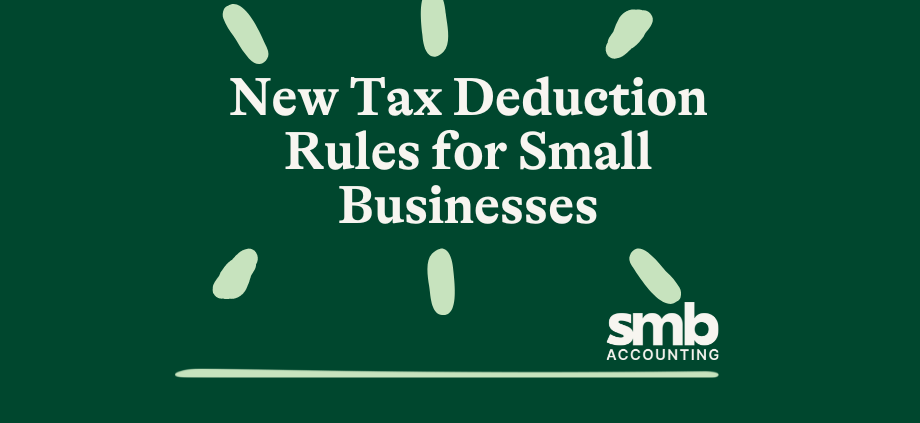Master the New Tax Deduction Rules for Small Businesses
Running a small business comes with its own set of challenges, but managing finances and taxes while staying compliant with regulations can be especially daunting. In an ever-changing tax landscape, understanding and keeping up with the latest tax deduction rules for small businesses is crucial. Having a comprehensive understanding of tax deductions can not only help you maximise your tax savings, but also enable you to stay compliant while doing so.
In this blog post, we will focus on the new tax deduction rules for small businesses, including changes made recently to support businesses affected by the pandemic. As your trusted partner in small business accounting, we will delve into the specific tax deductions available to you and provide you with practical advice on how to maximise these deductions.
By diving into these topics and providing practical solutions, we aim to equip small businesses with the knowledge and tools to successfully navigate the latest tax deduction rules. Don’t let the complexity of tax laws hinder your business’s success.
1. Overview of the Latest Tax Deduction Rules
The Australian Government continually updates tax legislation to support small businesses, especially during these challenging times. Here are the latest tax deduction rules you need to be aware of:
– Instant Asset Write-Off: This allows eligible small businesses to claim an immediate tax deduction for the full cost of certain business assets. As of July 2020, the threshold for immediate write-off has increased to $150,000, with the eligibility expanded to businesses with an annual turnover of up to $500 million.
– Temporary Full Expensing: Introduced in the 2020-21 Budget, Temporary Full Expensing offers businesses the chance to deduct the full cost of eligible business assets in the year they are first used or installed. This scheme is available for new or second-hand assets acquired from 6 October 2020 until 30 June 2023.
– Loss Carry-Back Tax Offset: This provision allows eligible businesses to ‘carry back’ any losses incurred in the 2019-20, 2020-21, and 2021-22 income years to offset against profits made in the 2018-19 income year or later. Businesses can claim a refundable tax offset equal to the tax paid on the carried-back losses but not exceeding the extent of cumulative losses.
– Simplified BAS Reporting: Businesses with an annual turnover of less than $10 million can now use the simplified Business Activity Statement (BAS) reporting method. This method simplifies reporting of Goods and Services Tax (GST), giving businesses more time to focus on their core operations.
2. Understanding Your Eligibility
Not all businesses will be eligible for every tax deduction. It’s essential to understand the specific requirements for each tax deduction before claiming:
– Instant Asset Write-off: You must be a small business with an annual turnover of up to $500 million. The asset must be a tangible, depreciating asset used for business purposes. It should be first used or installed and ready for use within the relevant income year.
– Temporary Full Expensing: To qualify, your business must have an aggregated turnover of less than $5 billion. The asset should be new or second-hand, acquired after 6 October 2020, and first used or installed by 30 June 2023.
– Loss Carry-Back Tax Offset: Your business must be a corporate tax entity with an aggregated turnover of less than $5 billion. The company must have made a profit in the relevant past year and not be part of a consolidated group at the time losses are claimed.
3. Steps to Claim Tax Deductions
Successfully claiming your tax deductions involves following these steps:
– Determine which deductions your business is eligible for based on the requirements outlined above.
-Maintain accurate records of your qualifying assets and their usage in your business operations.
-Incorporate the relevant tax deductions into your accounting software, such as Xero, to ensure accurate calculations.
-Complete and lodge your tax returns as required, including the appropriate deductions and documentation.
4. Record-Keeping Best Practices
Effective record-keeping is essential for supporting your tax deduction claims. To avoid potential non-compliance penalties, follow these best practices:
– Maintain accurate and organised records of all your business assets, expenses, and income.
– Keep digital or paper copies of all receipts, invoices, and contracts related to your business assets.
– Retain asset records for at least five years from the date of your last claim.
– Regularly review and update your records to ensure accuracy and compliance.
5. Expert Accounting Advice
SMB Accounting offers specialised accounting services tailored to small businesses, ensuring your tax deductions are optimised and effectively managed. Our team of experts will assist with the complexities of tax law, helping you stay compliant while minimising your tax obligations. With Xero accounting software, we can simplify your accounting processes, making it easier for you to manage your small business’s finances.
Conclusion
Tax deductions can provide significant savings for small businesses, but navigating the constantly changing tax landscape is no easy feat. Understanding and implementing the latest tax deduction rules can maximise your tax savings and ensure compliance. Partnering with SMB Accounting can provide you with the expertise and resources necessary to navigate tax deductions successfully, allowing you to focus on what you do best – running your business. We are here to help you navigate these intricate tax laws and provide guidance along the way. Contact us to learn more and meet with one of our tax consultants.

